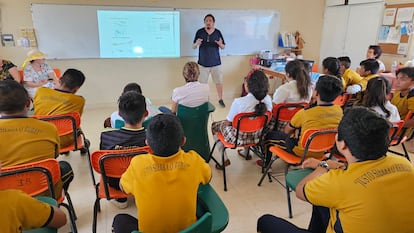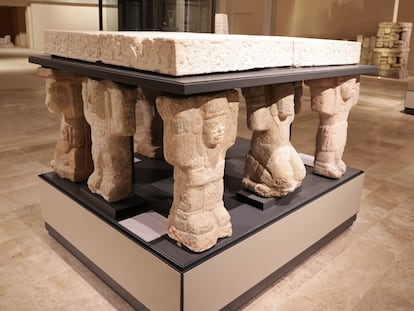DNA uncovers the mystery of the children sacrificed by the Mayans in Chichén Itzá
The analysis of 64 sets of human remains suggests that the civilization selectively sacrificed twins or brothers — always boys and in pairs — as a religious ritual
In 1967, workers building an airstrip near the mythical Mayan city of Chichén Itzá in Yucatán (Mexico) discovered a subway cavity full of human bones. The remains were collected, the cave was destroyed, and since then the find has been one of the greatest enigmas surrounding the Mayan culture. The young age of the more than 100 deceased made it impossible to know whether they were boys or girls, to the frustration of researchers trying to understand why the Maya performed frequent human sacrifices. Now, DNA analysis of 64 of the victims has shed light on who they were, and offers some clues as to why they were killed.
Chichén Itzá — with its pyramid of Kukulkán, the mythological feathered serpent, the Mesoamerican ballgame, its astronomical observatory and 50,000 inhabitants — was the epicenter of the Mayan civilization, which expanded throughout the Yucatán peninsula, Belize, and Guatemala and endured for centuries before collapsing around the year 1000 A.D.
Within the religious precinct is also the Sacred Cenote, a large hole in the ground filled with fresh water that the Maya considered the entrance to the underworld. A multitude of human remains have been found in its depths. Very close by is another cavity discovered in 1967 and known as chultún. It probably served as a fresh water cistern and, later, as an improvised sepulcher for the sacrificed.

Rodrigo Barquera, a Mexican paleogeneticist working at the Max Planck Institute for Evolutionary Biology in Germany, is one of the leaders of an investigation that began in 2014 to send the remains of the 64 corpses to Leipzig, extract a few milligrams of the petrous bone of the skull — one of the densest in the body — and recover their DNA. The results show that all the children were boys aged between three and six. They were killed across a timespan of five centuries, from the 6th to the 10th A.D., although the sacrifices intensified in the period of maximum splendor and the later collapse of the Mayan capital, between 800 A.D. and 1000 A.D, according to the study, published Wednesday in Nature.
The most surprising finding was that among the dead, there are two pairs of twin brothers who were probably sacrificed together. Among the rest of the victims there are also close kinship ties; some were siblings, others cousins, so there was probably a clear physical resemblance between them.
The Mayan civilization had a special obsession with twins. Their sacred book, the Popol Vuh, which dates from colonial times but in theory existed at the dawn of their culture, tells the myth of two twins who descend to the underworld and are sacrificed by the gods after a ballgame. The head of one of them impregnates a virgin, who gives birth to two identical brothers who return to the underworld in search of revenge, in a continuous cycle of sacrifices. Researchers believe that all the children were killed in pairs and at the same time, in a sort of homage to the “hero twins.”
Oana del Castillo, a bioarcheologist at the Mexican National Institute of Anthropology and History, and co-author of the study, elaborates on this interpretation. According to the myth, “this pair of twins faces death and darkness to guarantee the continuity of the cosmic cycles, and with it, life on the surface of the Earth,” she explains by e-mail.
Until now it was thought that all those sacrificed were girls or adolescents. One of the first to propose this theory was Edward Herbert Thompson — Don Eduardo — architect of the plundering of this “American Egypt,” as Chichén Itzá was known after its rediscovery in the 19th century. At the beginning of the 20th century, Thompson was appointed consul of the United States in Yucatán. In just a few years, he dredged the Sacred Cenote with cranes and removed hundreds of bones and gold and jade objects that were sent to the Peabody Museum at Harvard University, where many of them remain. In the book chronicling Thompson’s excavations, The City of the Sacred Well, Don Eduardo speculates that the sacrificed women were Mayan princesses who were thrown alive into the deep waters of the cenote to satisfy the gods.

The bodies analyzed carry no physical traces of violence. There are no signs of decapitation or extraction of the heart, rituals that were more typical of the Aztecs, and which in this case are much better-documented by the testimonies of the Spanish conquistadors who arrived at Tenochtitlan, in present-day Mexico City. Despite this, Barquera explains that sacrifice is the most plausible option. “At that time, children who died of diseases usually died within the first two years of life. It is rare to find so many dead aged between three and six years old. Also, if it were a burial, we would see a mix of sexes, but here there is a clear pre-selection of males. Many of them were related. And we also found two sets of twins. The possibility of it being a product of chance is practically zero,” he explains.
Another factor that supports the theory of ritual sacrifice is diet. The researchers analyzed the different types of hydrogen atoms (isotopes) found in the bones, as well as the carbon-14 that allows the refining of their dating. This part of the work was carried out by Spanish researcher Patxi Pérez-Ramallo, who works at the Norwegian University of Science and Technology. “It was a huge challenge,” he explains over the phone. “It took a long time to understand the diet from the isotopes. Then we saw that there are three large groups, some who came from the coast and ate more fish protein, others from inland who consumed more meat, and others who had a humbler diet, which points to the fact that they were lower-class.” What is most relevant is that the diet of each pair of sacrificed children is practically identical, which suggests that they received the same care and food in the months or years prior to their sacrifice. The majority of deaths are concentrated in the 8th and 9th centuries A.D., taking place approximately every 50 years, which may coincide with periods of food shortages and, consequently, of political and social instability.
Barquera compares what happened in the ceremonial complex of Chichén Itzá with what can be seen in any church or synagogue: “In these temples we see different rooms dedicated to each rite,” he explains. “In the Mayan city, the chultún would be used for sacrifices in homage to the hero twins. However, in the Sacred Cenote, we know that the sacrificed were thrown in alive when it was completely dry, as a petition for the rains to come.”

For Pérez-Ramallo there is nothing comparable to the volume and cultural complexity of these human sacrifices conducted by the Maya, which were sustained for centuries. The closest, he believes, are the sacrifices of young women and their children by the Incas, whose exceptionally preserved mummies have been found on some of the highest peaks of the Andes. In these cases, it has also been shown that they came from remote places and ate the same diet, but those were two or three cases, not dozens or even hundreds.
The authors of the work warn that it is inadvisable to interpret what happened in the Mayan city from a modern-day perspective. “When I analyze things like this, I try to be a mere witness and not judge with the eyes of the present,” says Pérez-Ramallo. However different the Mayan world may be from the European Middle Ages, of which he is a specialist, there are always connections. “When the Romans arrived in Lusitania [present-day Portugal, Extremadura, and Salamanca, in Spain], they witnessed human sacrifices by the local population. These are anthropological behaviors that explain a society, rather than barbarism,” he notes.
His colleague Barquera adds: “In those times, in Mesoamerica, sacrificial death was an honor. In the ballgame you aspired to win, and the prize was to be sacrificed. Giving your children in sacrifice was probably also a great honor. From our point of view it seems barbaric, but this is how the world was understood a little more than 1,000 years ago. It’s something different that we can’t qualify with today’s morals.”
The team also analyzed the DNA of 68 current inhabitants of Tixcacaltuyub, a town near the ruins of Chichén Itzá. The results show that the descendants of the Mayan peoples retain genetic marks of the epidemics that decimated the American population after the arrival of the conquistadors in the 16th century, especially genes resistant to the bacterium Salmonella enterica, which in 1545 caused the so-called cocoliztli epidemic.
Iñigo Olalde, a geneticist at the University of the Basque Country, believes that this is a “unique” study. “It is exceptional to be able to recover DNA from so many individuals in a warm region. And thanks to the genetic extraction it has been possible to determine the gender, since no physical trait in the bones of young children allows us to differentiate between them. Thanks to this, we know who was being ritually killed,” he says.
Sign up for our weekly newsletter to get more English-language news coverage from EL PAÍS USA Edition











































